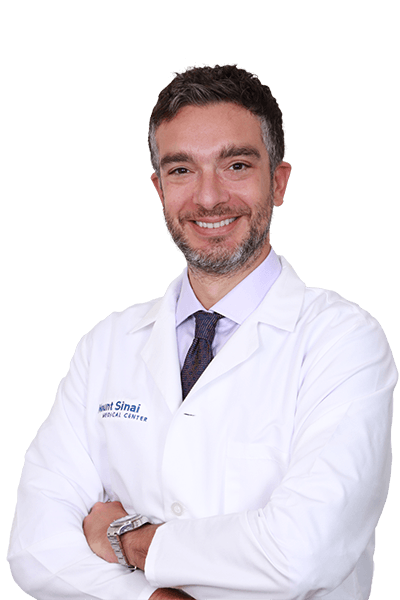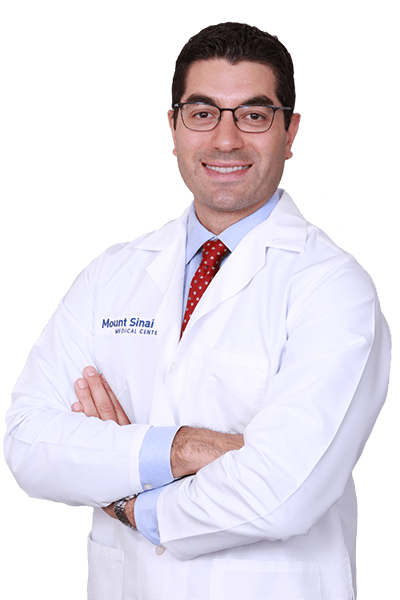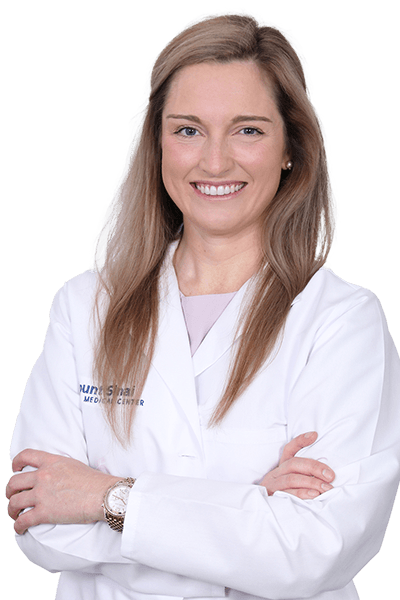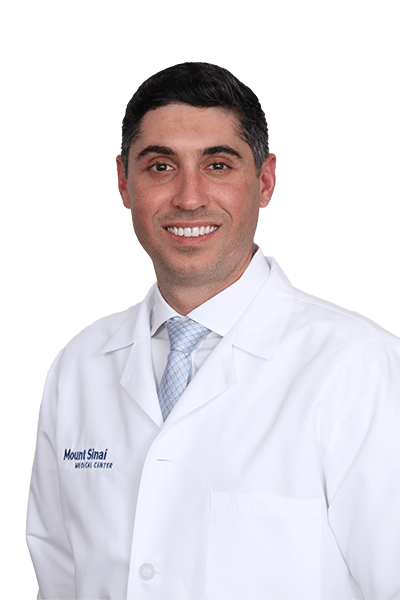Joint Replacement, Limb Lengthening, Limb Deformity, & Joint Preservation
Joint Replacement
Millions of Americans suffer from pain in their joints that can only be alleviated through joint replacement surgery.
At Mount Sinai Medical Center, we have assembled a multidisciplinary team of orthopedic surgeons, physical therapists, nursing staff, and imaging experts to provide patients with a holistic approach to joint replacement. While arthritis is the most common source of pain and discomfort leading to a joint replacement surgery, we also treat a number of conditions and syndromes with joint replacement, including defects that a patient may have been born with, injuries or trauma that require joint replacement, or even diseases and infections.
In all cases, your Mount Sinai orthopedic specialists will use the most advanced techniques to resolve your joint problems, including brand-new surgical approaches, such as anterior-approach hip replacement, and state-of-the-art medical devices, including ceramic and 3-D printed artificial joints, as well as robotic surgical technology.
With joint replacement at Mount Sinai, you can look forward to regaining a more active lifestyle, less pain, and peace of mind that you’re receiving care from some of the region’s most expert orthopedic surgeons. Our team performs the following types of joint replacement:
Ankle Replacement (ankle arthroplasty)
An alternative to ankle fusion, an ankle replacement consists of removing the worn-down parts of the ankle bones and replacing them with metal implants. At Mount Sinai, we use the most advanced implants that are produced using 3-D printed templates. These new implants can be placed more quickly, reducing surgical time. They also last longer than older implants. Best of all, most patients who undergo an ankle replacement at Mount Sinai go home the same day of their procedure.
Elbow Replacement
Elbow replacement surgery involves removing the worn, degenerated bone and replacing it with metal implants. Elbow replacement surgery dramatically alleviates arthritis pain and allows patients to regain their full range of elbow motion.
Hand and Finger Arthroplasty
Depending on your specific case and the cause of your finger and hand pain, you might be eligible for a joint replacement. In these cases, joint replacement will improve the range of motion in your hand and fingers and alleviate pain.
Hip Replacement
Arthritis of the hip is one of the most debilitating conditions affecting the skeletal system. As a result, patients who undergo hip replacement surgery and experience dramatic pain relief report some of the highest satisfaction rates of any orthopedic surgical procedure. At Mount Sinai, our hip replacement patients benefit from new cutting-edge surgical techniques, including the muscle-sparing anterior hip approach, where we replace the hip bone from the front side instead of from behind, as was done in the past. We also use advanced technology, such as the da Vinci robot, along with new postoperative pain management protocols. The combination of these innovative approaches to hip replacement allows our patients to enjoy dramatically better recoveries than in the past.
Knee Replacement
Knee replacements are indeed among the most prevalent joint replacement surgeries, and at Mount Sinai, we are at the forefront of this field. Performing both partial and total knee replacements using advanced techniques like minimally invasive procedures and ROSA® Knee robotic technology. Knee replacement surgery is a crucial solution for patients with debilitating knee conditions, and our innovative approach coupled with comprehensive postoperative care ensures exceptional patient outcomes and improved quality of life.
ROSA® Knee: Advanced Robotic Knee Replacement Surgery
At Mount Sinai Medical Center, we’re proud to offer the latest advancements in knee replacement surgery, including the revolutionary ROSA® Knee technology. With ROSA® Knee, our expertly trained orthopedic surgeons combine robotics with industry-leading knee implants to provide personalized care tailored to your unique needs.
Mount Sinai’s Orthopedics Program integrates Zimmer Biomet’s ROSA Knee robotic technology into its advanced treatment options for total knee replacement. ROSA (Robotic Surgical Assistant) Knee ensures precise placement of knee implants tailored to each patient’s unique anatomy.
Why ROSA® Knee stands out:
- Personalized Precision: ROSA® Knee utilizes state-of-the-art robotics to ensure precise implant fit, leading to improved accuracy and better outcomes for our patients.
- Faster Recovery: Experience accelerated recovery times compared to traditional knee replacement surgery, allowing you to get back to your daily activities sooner.
- Enhanced Patient Care: With ROSA® Knee, our surgeons have access to advanced data collection and analytics, allowing for a personalized approach to your knee replacement surgery journey.
- Minimally Invasive Techniques: Benefit from minimally invasive surgical techniques, resulting in smaller incisions, reduced trauma to surrounding tissues, and less postoperative pain.
Discover how ROSA® Knee is transforming knee replacement surgery at Mount Sinai Medical Center, where our commitment to innovation and patient-centered care ensures you receive the highest quality treatment possible. Our Orthopedics Program is dedicated to empowering patients with the information they need to make informed decisions about their orthopedic care, striving to deliver personalized, precise, and effective treatment options tailored to each patient’s unique needs through the integration of ROSA Knee robotic technology.
Shoulder Replacement
A shoulder replacement involves removing the worn, degenerated bone and replacing it with metal implants. There are two common types of shoulder replacements; an anatomic shoulder replacement and a reverse shoulder replacement. Your Mount Sinai shoulder specialist will discuss which type of shoulder replacement is best for you.
Wrist Replacement
Certain conditions, such as arthritis or avascular necrosis (where one or more wrist bones do not get enough blood and the bone begins to die), can lead to pain, limited range of motion, and the inability to use your wrist normally. Mount Sinai’s hand specialists can replace the degenerated or non-viable bones with implants that restore a full range of wrist motion and relieve your wrist pain.
Limb Lengthening, Limb Deformity, & Joint Preservation
Many patients have never heard of limb lengthening; however, it’s very real approach to addressing limb deformities, such as bow leggedness or knock knees. Patients with short stature can also benefit from limb lengthening procedures.
Limb Length Discrepancy (different length legs) is the most common reason patients request limb lengthening procedures here at Mount Sinai and other medical centers with highly advanced orthopedic surgical capabilities. In fact, the physician of the Columbia University Orthopedics at Mount Sinai Medical Center are among only a handful of orthopedic programs in the nation to offer these complex surgeries.
Conditions & Treatment
Limb Length Discrepancy (LLD)
Limb length discrepancy is a difference between the lengths of the arms or legs. Except in extreme cases, differences in arm length do not usually impact how the arms function and do not always require treatment.
While a slight difference in leg length (<1cm) may not cause symptoms, larger differences secondary to congenital deformities, traumas, or previous surgeries can cause lower back, hip, knee and ankle pain, and imbalanced gait resulting in a limp.
Mild leg-length discrepancies may be addressed with a shoe lift. More significant differences in leg length tend to require a surgical procedure such as limb lengthening.
Knock Knees
Genu valgum, or “knock knees,” is a developmental condition that causes the knees to bend in toward one another, creating a gap between the ankles when the patient stands with their knees together. The name comes from how the knees “knock” against each other when standing or walking normally.
Knock knees frequently occur in children aged three to six, are slightly more common in girls than boys, and most often go away on their own as the child grows. If they persist after the age of eight and into adulthood, it may indicate knock-knee syndrome, a condition that places undue stress on the outward facing side of each knee, which can lead to meniscus and cartilage injury, and knee arthritis over time.
Surgery, consisting in realignment of one or both knee bones, is indicated in said cases to improve pain, improve outcomes after meniscus surgery, and ultimately delaying the onset and progression of knee arthritis. Studies have in fact observed that knee realignment surgery in already arthritic knock knees may delay the need of a knee replacement by 10-15 years.
Bowlegs
Genu varum, or “bowlegs,” is a developmental condition that causes the legs to curve outward so that the knees splay apart even when the patient stands with their feet and knees together. The name comes from how the legs “bow” outward, leaving a wide gap between the knees when the patient stands naturally.
Bowlegs are very common in infants and young children, with many babies born bowlegged in response to their folded position in the womb. Most grow out of the condition within the first two years. If the condition persists into adulthood, it may cause bowleg syndrome. This condition can cause pain on the inside part of the knee, may be responsible for meniscus tears, and can lead to knee arthritis. A times, the deformity can progress over time if untreated, causing worsening of the symptoms.
As with knock knees, there are a variety of surgical options for treating bowlegs that can improve the appearance and function of the joints, delaying the onset and progression of arthritis. Studies have in fact observed that knee realignment surgery in already arthritic bow legs may delay the need of a knee replacement by 10-15 years.
Limb Lengthening Surgery
Whether for functional purposes or cosmetic reasons, reconstructive limb lengthening limb lengthening is performed with a telescopic magnetic rod, which is inserted into the bone. The surgeon breaks the bone, and then the rod is lengthened by approximately 1mm per day. A patient can expect to increase her or his height by up to three inches with one surgery. Surgeons can repeat this procedure to double the increase to three additional inches for a total increase in height of six inches.
During a limb lengthening surgery, the highly qualified physician surgically separates the bone and distracts (pulls apart) the segments very slowly so that new bone continues to form in the gap. This is accomplished by inserting a sophisticated, new generation limb lengthening device. This device will be used to widen the gap between the two sections as the bone slowly heals and regenerates to fill in the empty space, eventually resulting in a longer leg bone.
Following distraction, the final stage of treatment is consolidation. During consolidation, the patient allows the natural healing process to continue strengthening and healing the bone and aiding the ligaments, muscles, nerves, and tendons surrounding the bone in adapting to their new physical configuration. The healing in this phase is bolstered by regular physical therapy and rehabilitation sessions, which began during the distraction phase. Lastly, the device is surgically removed after the desired length has been reached and the bone has sufficiently healed.
Understanding Arthritis
Osteoarthritis (OA) is a common cause of joint pain, resulting from the breakdown of joint cartilage. As cartilage wears away, bones make painful bone-on-bone contact, leading to discomfort and reduced mobility. While early-stage OA can often be managed with conservative treatments, advanced cases may require surgical intervention. Diagnosis involves assessing movement, reviewing health history, and conducting X-rays. Total joint replacement surgery is effective in restoring motion and reducing pain, particularly in commonly affected joints like knees, hips, fingers, and shoulders. Symptoms may include joint pain, instability, decreased activity, and abnormal stance or gait. Non-surgical treatments like exercise and weight management can help alleviate joint pain and improve mobility.
Our Physicians
Ettore Vulcano, MD
Chief, Division of Orthopedic Surgery
Director, Foot and Ankle Surgery
Associate Professor at the Columbia University Division of Orthopedic Surgery at Mount Sinai Medical Center
- Orthopedics
- Orthopedic Surgery
- Joint Replacement
- Foot and Ankle Surgery
- Mount Sinai Medical Center (Main Campus)
- 305.674.2090
- Mount Sinai Emergency Center, Physician Offices, Cancer Center and Diagnostic Center Aventura
- 305.674.2090
- Mount Sinai Medical Center, Kenneth C. Griffin Center, Hialeah – Emergency Center and Primary & Specialty Care | Mount Sinai Eldercare
- 786.584.5555
Karim Sabeh, MD
Director, Adult Reconstruction and Arthroplasty
Assistant Professor of Orthopedic Surgery at the Columbia University Division of Orthopedic Surgery at Mount Sinai Medical Center
- Orthopedics
- Orthopedic Surgery
- Hip & Knee
- Mount Sinai Medical Center (Main Campus)
- 305.674.2090
Stephanie S. Shim, MD
Director, Hand and Upper Extremity Surgery
Assistant Professor at the Columbia University Division of Orthopedic Surgery at Mount Sinai Medical Center
- Orthopedics
- Hand Surgery
- Orthopedic Surgery
- Mount Sinai Medical Center (Main Campus)
- 305.674.2090
- Mount Sinai Emergency Center, Physician Offices, Cancer Center and Diagnostic Center Aventura
- 305.674.2090
Danica D. Vance, MD
Director, Sports Medicine
Assistant Professor at the Columbia University Division of Orthopedic Surgery at Mount Sinai Medical Center
- Orthopedics
- Sports Medicine
- Orthopedic Surgery
- Mount Sinai Medical Center (Main Campus)
- 305.674.2090
- Mount Sinai Emergency Center, Physician Offices, Cancer Center and Diagnostic Center Aventura
- 305.674.2090
Kathryn L. Fideler MD, MPH
Assistant Professor at the Columbia University Division of Orthopedic Surgery at Mount Sinai Medical Center
- Orthopedics
- Orthopedic Surgery
- Hip & Knee
- Adult Reconstruction
- Mount Sinai Emergency Center, Physician Offices, Cancer Center and Diagnostic Center Aventura
- 305.674.2090
Joseph Barbera, MD
- Orthopedics
- Orthopedic Surgery
- Adult Reconstruction
- Mount Sinai Medical Center, Kenneth C. Griffin Center, Hialeah – Emergency Center and Primary & Specialty Care | Mount Sinai Eldercare
- 786.584.5555







